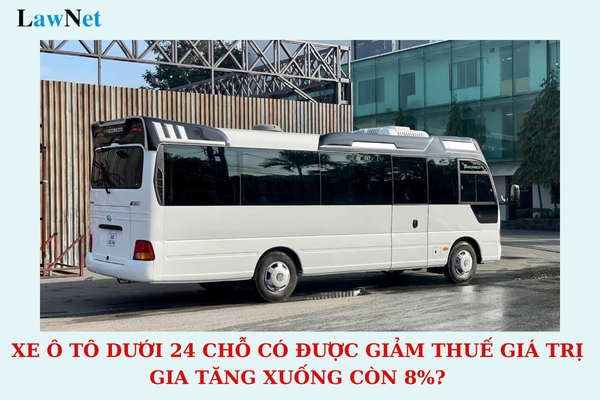Are automobiles with fewer than 24 seats eligible for a VAT reduction to 8% in Vietnam under Decree 72?
Are automobiles with fewer than 24 seats eligible for a VAT reduction to 8% in Vietnam under Decree 72?
According to Annex II issued in conjunction with Decree 72/2024/ND-CP, the list of goods subject to special consumption tax that are not eligible for VAT reduction includes:
- Cigarettes, cigars, and other tobacco products for smoking, inhalation, chewing, sniffing, or sucking;
- Alcohol;
- Beer;
- Automobiles with fewer than 24 seats, including those designed to both carry passengers and freight with more than two rows of seats and a fixed partition between the passenger and cargo compartments;
- Motorcycles with an engine capacity of over 125 cm3;
- Aircraft, yachts;
- All types of gasoline;
- Air conditioners with a capacity of 90,000 BTU or less;
- Playing cards;
- Votive papers and similar items.
Thus, it can be seen that automobiles with fewer than 24 seats, including those designed to carry both passengers and cargo with more than two rows of seats and a fixed partition, are not eligible for a VAT reduction from 10% to 8%.

Are automobiles with fewer than 24 seats eligible for a VAT reduction to 8% in Vietnam under Decree 72? (Image from the Internet)
Which goods and services are eligible for a VAT reduction to 8% in Vietnam?
According to Article 1 of Decree 72/2024/ND-CP, goods and services eligible for a VAT reduction to 8% include groups of goods and services currently subject to a 10% tax rate, excluding the following groups:
- Telecommunications, financial activities, banking, securities, insurance, real estate business, metals and fabricated metal products, mining products (excluding coal), coke, refined petroleum products, chemical products. Details in Annex I attached to Decree 72/2024/ND-CP.
- Goods and services subject to special consumption tax. Details in Annex II attached to Decree 72/2024/ND-CP.
- Information technology as per regulations on information technology. Details in Annex III attached to Decree 72/2024/ND-CP.
- The VAT reduction for each type of goods and services is uniformly applied across importation, production, processing, and commercial stages.
Regarding coal extracted for sale (including coal that is extracted, then screened, and classified following a closed process before being sold) is eligible for VAT reduction. Coal categorized in Annex I issued with Decree 72/2024/ND-CP, except for the extraction sale stage, is not eligible for VAT reduction.
Corporations and economic groups that conduct a closed process before selling also fall under the category eligible for VAT reduction on coal extracted for sale.
In the case that goods and services listed in Annexes I, II, and III issued in conjunction with Decree 72/2024/ND-CP are subjects exempt from VAT or are subject to 5% VAT, they shall comply with the provisions of the Law on Value-Added Tax 2008 and are not eligible for VAT reduction.
What are the methods for calculating VAT in Vietnam?
According to Article 9 of the Law on Value-Added Tax 2008, there are two methods of calculating value-added tax:
(1) The deduction method (Article 10 Law on Value-Added Tax 2008) is as follows:
- VAT payable under the deduction method is equal to output VAT minus deductible input VAT;
- Output VAT is the total VAT of goods and services sold recorded in the VAT invoice;
- Deductible input VAT is the total VAT recorded in the VAT invoice for purchased goods and services, the VAT payment document for imported goods that meet the conditions specified in Article 12 of the Law on Value-Added Tax 2008.
- The deduction method applies to business establishments that fully comply with the accounting, invoices, and vouchers policies as prescribed by law and register to pay tax under the deduction method.
(2) The direct method on added value (Article 11 Law on Value-Added Tax 2008) is as follows:
The VAT payable under the direct method on added value is equal to the added value multiplied by the VAT rate applicable to the activities of trading and processing gold, silver, and precious stones.
The added value of gold, silver, and precious stones is defined as the selling price minus the purchase price of the corresponding goods.
The VAT payable under the direct method on added value is calculated by multiplying a percentage rate by revenue, applied as follows:
- Applicable entities:
+ Enterprises and cooperatives with an annual revenue below the one-billion-dong threshold, except for those that voluntarily register to apply the deduction method as specified in Clause 2, Article 10 of this Law;
+ Households, individual businesses;
+ Foreign organizations and individuals conducting business without a permanent establishment in Vietnam but having generated income in Vietnam that do not fully comply with the policies on accounting, invoices, and vouchers, except for foreign organizations and individuals supplying goods and services to carry out petroleum exploration and exploitation activities that pay tax using the deduction method withheld by the Vietnamese party;
+ Other economic organizations, except those registering to pay tax by the deduction method as specified in Clause 2, Article 10 of the Law on Value-Added Tax 2008;
- The percentage rate for calculating VAT is specified as follows:
+ Distribution and supply of goods: 1%;
+ Services, construction without supply of materials: 5%;
+ Production, transportation, services attached to goods, construction inclusive of raw materials: 3%;
+ Other business activities: 2%.

